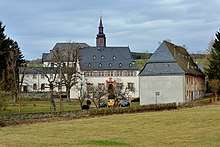Rupert I, Count of Laurenburg
Rupert I of Laurenburg, German: Ruprecht I. von Laurenburg († before 13 May 1154),[1][2] was count of Laurenburg and one of the ancestors of the House of Nassau.
Rupert I, Count of Laurenburg | |
|---|---|
| Born | ? |
| Died | before 13 May 1154 |
| Noble family | House of Nassau |
| Spouse(s) | Beatrix of Limburg |
| Father | Dudo of Laurenburg |
| Mother | The fourth of the seven daughters of count Louis I of Arnstein |
Biography


Rupert was a son of Dudo of Laurenburg (German: Dudo von Laurenburg) and the fourth of the seven daughters of count Louis I of Arnstein, possibly her name was Irmgardis or Demudis.[1]
Rupert is mentioned as count of Laurenburg between 1124 and 1152. He probably ruled together with his brother Arnold I.[1][2] Rupert and Arnold built Nassau Castle around 1120.[2]
In 1124, Rupert became the Bishopric of Worms's Vogt over the Weilburg Diocese. He inherited this position from the Hessian Count Werner IV of Gröningen. Idstein, which had come under the control of Dudo in 1122, was also added to this fief. Through this, Rupert was able to decisively expand the possessions of his House. He gained, among other lands, the village of Dietkirchen and established himself in the Haiger Mark.
Along with numerous property and lordship rights in the Westerwald and Dill River region, Weilburg's territory included the former Königshof Nassau, which had fallen to Weilburg in 914. This did not, however, settle the dispute with the Bishop of Worms over the legality of constructing Nassau Castle.
Rupert had little luck in this dispute between his house and the Bishop of Worms over the sovereignty over Nassau Castle. He was excommunicated by Pope Eugene III.[3] The dispute was settled through the intervention of the Archbishop of Trier in 1159, about five years after Rupert's death.
In 1126, Rupert endowed the Benedictine Schönau Abbey near Lipporn. The land had already in 1117 been donated by Count Dudo to Schaffhausen Abbey for construction of a monastery. Under Rupert's rule, from 1126 to 1145, the Romanesque buildings were constructed, presumably including a three-nave basilica. The Abbey included both a monastery for monks and a convent for nuns. From 1141 until her death in 1164, the abbey convent would be the home of St. Elizabeth of Schönau.
Rupert is mentioned in a charter from 1132 as Lord of Miehlen.[2]
Rupert is regularly mentioned on court days and the Imperial Diet of King Conrad III of Germany, for example during Christmas 1146 in Speyer, where Bernard of Clairvaux preached the crusade. Rupert often appears as witness in royal charters.[3]
Rupert had continual disputes with several of his neighbors. He was a loyal follower of the Hohenstaufen Emperors. He died before 13 May 1154.
Marriage and children
Rupert married before 1135, possibly c. 1125,[1] to Beatrix of Limburg († 12 July after 1164, still mentioned in 1165),[1] daughter of Walram II the Pagan, Count of Limburg and Duke of Lower Lorraine, and Jutta of Guelders (daughter of Count Gerard I of Guelders).[2]
From this marriage the following children were born:[1][2][4]
- Arnold II of Laurenburg († 1158/1159), mentioned as count of Laurenburg 1151–1158.
- Rupert II of Laurenburg († ca. 1159), mentioned as count of Laurenburg 1154–1158.
In a charter from 1148 a certain Gerhard of Laurenburg is mentioned, who quite possibly was a younger son of Rupert I, however his relationship does not appear in any charter.[1][5] No marriage is mentioned for this Gerhard.[1]
External links
- Die territoriale Entwicklung Nassaus, by Ulrich Reuling (in German).
- Family tree of the early House of Nassau.
- Nassau in: Medieval Lands. A prosopography of medieval European noble and royal families, compiled by Charles Cawley.
Sources
- This article incorporates text translated from the corresponding German Wikipedia article, as of 2009-01-21 and from the corresponding Dutch Wikipedia article, as of 2019-06-15.
- Brandenburg, Erich (1998). Die Nachkommen Karls des Großen [The Descendants of Charlemagne] (in German). Neustadt an der Aisch: Verlag Degener & Co.
- Dek, A.W.E. (1970). Genealogie van het Vorstenhuis Nassau [Genealogy of the Royal House of Nassau] (in Dutch). Zaltbommel: Europese Bibliotheek. OCLC 27365371.
- Hesselfelt, H.F.J. (1965). "De oudste generaties van het Huis Nassau" [The oldest generations of the House of Nassau]. De Nederlandsche Leeuw, Maandblad van het Koninklijk Nederlandsch Genootschap voor Geslacht- en Wapenkunde [The Dutch Lion, Monthly Journal of the Royal Dutch Society for Genealogy and Heraldry] (in Dutch). 1965 (11): 354–365.
- Sauer, Wilhelm (1889). "Ruprecht I., Graf von Laurenburg" [Ruprecht I, Count of Laurenburg]. Allgemeine Deutsche Biographie [Universal German Biography] (in German). Band 29. Leipzig: Duncker & Humblot. p. 730.
- Schwennicke, Detlev (1998). Europäische Stammtafeln, Neue Folge [European Genealogies, New Series] (in German). Band I. Frankfurt am Main: Vittorio Klostermann GmbH. ISBN 3-465-02743-4. Table 60.
- Thiele, Andreas (1994). Erzählende genealogische Stammtafeln zur europäischen Geschichte, Band I, Teilband 2: Deutsche Kaiser-, Königs-, Herzogs- und Grafenhäuser II [Annotated genealogies from European History, Volume 1, Part 2: German Imperial, Royal, Ducal and Comital Houses II] (in German) (2nd ed.). Frankfurt am Main: RG Fischer Verlag. ISBN 3-89501-023-5.
References
- Hesselfelt (1965).
- Dek (1970).
- Sauer (1889).
- Cawley.
- Some sources consider Gerhard, to be the son of Rupert I's brother, Arnold I. See: Family tree of the early House of Nassau, retrieved on 2009-01-22. However, Erich Brandenburg in his Die Nachkommen Karls des Großen states that it is most likely that Gerhard was Rupert I's son, because Gerhard was the name of Beatrix of Limburg's maternal grandfather. See: Table 11, Page 23 and note on page 151, quoted at Genealogy of the Middle Ages Archived 2011-06-29 at the Wayback Machine, retrieved on 2009-01-23.
| German nobility | ||
|---|---|---|
| Preceded by - |
co-Count of Laurenburg (with Arnold I) 1124–1152 |
Succeeded by Arnold II and Rupert II |